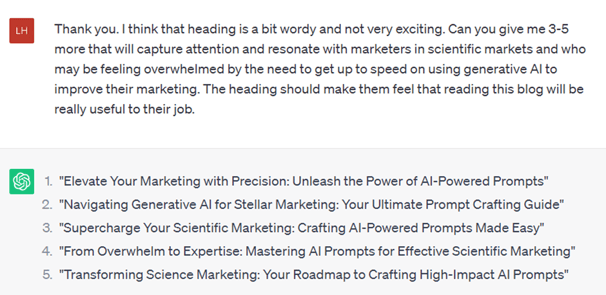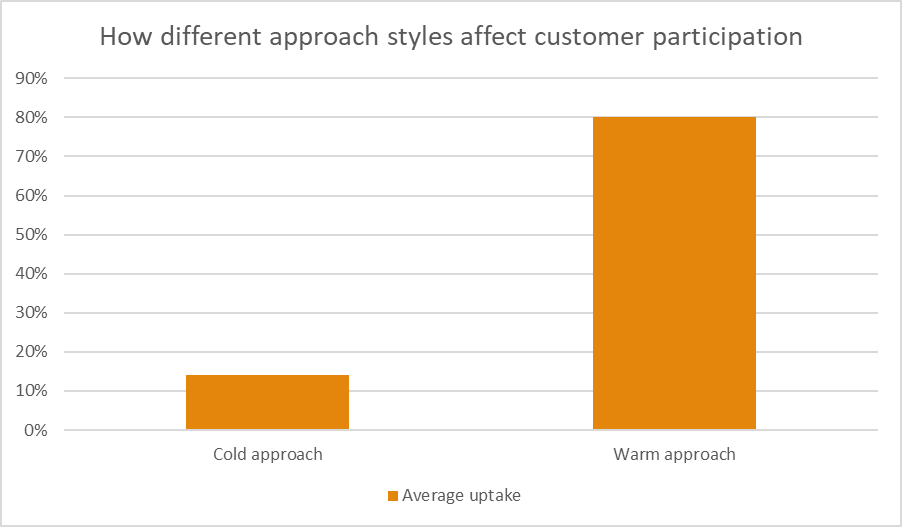We have been using generative AI tools and reading / talking about them A LOT. Our overall stance is (no surprises here), that dismissing generative AI isn't an option. We must adapt, cautiously, keeping our clients' unique needs, challenges and goals at the forefront of everything we do, no matter how we do it.
That said, we quickly came to understand that for communications experts, the key to harnessing AI’s undoubted potential is in learning one very fundamental skill: we’re calling it ‘prompt craft’.
We’ve learned through many long-winded, frustrating ‘conversations’ with ChatGPT and Bard AI that the quality of output directly correlates to the quality of input. This really shouldn’t come as a surprise – it is exactly the same for any briefing process between us mere mortals.
Crafting well-defined prompts can massively influence the quality and relevance of the generated content. So here are some of our tips:
-
Be clear and specific:
Clearly communicate what you're asking for. Vague or ambiguous prompts will lead to off-topic, or bland responses. -
Provide context:
Always give some context about the subject, audience, or purpose of the content. This helps the AI generate content that aligns with your requirements. -
Use examples:
Include sample sentences, phrases or keywords to guide the AI's tone, style, and direction. Note that using a ChatGPT Chrome extension, you can now upload various types of files to ChatGPT. -
Break down complex tasks:
If you want a comprehensive output, break down the task into smaller sub-questions or sections. A top tip is to explain what you are looking for, but add ‘Don’t write the blog yet, confirm that you understand’. You can then build a clear picture without it going off and producing content before you’ve given it all the information. -
Ask for alternatives:
If you're not satisfied with the initial output, ask the AI to generate alternative versions or viewpoints, explaining what you didn’t like and what you’d prefer to see. -
Iterate:
You will likely always need to refine and iterate your prompts. You can improve the results – and your overall prompt craft skills – through lots of trial and error. Have fun with it, it amazes us regularly how useful generative AI can be! -
Avoid open-ended queries:
Without some structure, AI might produce meandering or irrelevant content. Provide at least some guidance. -
Avoid repetitive phrasing:
Using the same phrasing repeatedly might result in the AI producing variations of the same content. -
Don't assume AI knowledge:
The AI won’t know the latest information beyond its training cut-off (especially ChatGPT). If you need up-to-date data, provide it in your prompt or document upload. -
Don't use the content wholesale:
Hopefully it goes without saying that you must always thoroughly review and edit any content generated by AI to ensure accuracy, adherence to brand guidelines, and alignment with your goals.
To note: we do not use generative AI to create final copy, and nor should anyone in our opinion, for now, at least!
Prompt craft in action
Here’s a good example of what we are discussing: we asked Chat GPT the following:

A bit blah…. so our next prompt was:

Numbers 3, 4 and 5 are pretty spot on, though you’ll notice we preferred our own! Hopefully this demonstrates the benefits of giving very clear instructions and feedback, it will usually be an iterative process, so don’t just live with the first response. This example also shows how AI can adjust the style very easily, with the right human input.
Some content ChatGPT came up with for us recently was very wordy and heavy going (blame it on the prompt!), so we asked it to rewrite it in a less pretentious way and it did exactly that! This shows that you really can talk to it like you might another person and it (usually) responds accordingly.
Can generative AI really deal with science?
When it comes to technical and scientific markets, beware of the well-cited flaws of generative AI tools, but don’t let them hold you back.
As highlighted by a recent study, ‘Large Language Models have the potential to generate false scientific claims that are indistinguishable from genuine research findings at first glance.’ So when drawing on AI to help create scientific content, or using it to explain scientific terms, or concepts, take a measured and thorough approach to fact checking, exactly as you would if you were using search.
If you’re using Bard AI, you can conveniently click ‘Google it’ and sometimes, it will provide citations in its response, but only if it copies directly from a source. If you ask it to provide references, more often than not, it won’t.
Having interacted with ChatGPT and Bard AI about a number of highly scientific subjects, we conclude that they can be helpful in providing context and explaining complex topics, but the best way to extract specialist knowledge for the most accurate and differentiating content, is still via scientists / researchers themselves!
In conclusion:
Remember that while generative AI tools can be incredibly powerful, they're far from perfect. The more you use them, over time, you'll develop your own style of framing prompts to get the best results for you and your organisation.
We do recommend that as well as ensuring you have your AI usage policy in place, you provide training and guidance to all market-facing employees on how to get the most out of generative AI. A good place to start is talking about ‘prompt craft’. Hopefully this blog has helped give you a little bit of inspiration!
The Scott Partnership Group has more than 25 years’ experience in helping technical and scientific organisations to communicate and grow, so why not get in touch and see how we can support.




